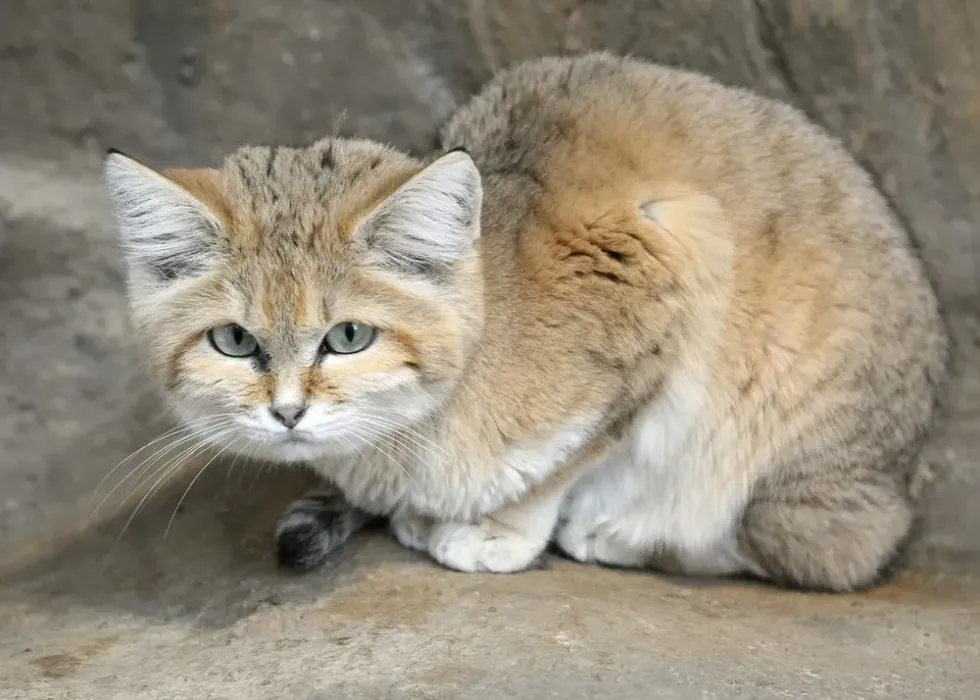The sand cat is a small, solitary cat native to Africa and Asia's deserts. They are the only cats known to adapt to deserts as their primary habitat. This cute little wild cat can live without water, sprint on the sand, and trace the prey underground.
They have a pale sandy to gray-brown coat, that gets slightly darker towards the back. The belly is pale yellow, and the cheeks are highlighted with red streaks that run across from the corners of both eyes. They have a broad forehead, greenish-yellow eyes ringed with white, and a blackish nose.
They are distinguished from other cats through their large ear pinnae, which protects them from blowing sand. The distinctly developed senses of this species are hearing and smelling.
Their thick fur cover coat plays a vital role for the animal to sustain in the extreme day ((124 F (51.1 C)) and night (31 F (-0.6 C)) temperatures. Their feet are padded with thick and wiry fur that protects them from hot surfaces and maintains their mobility in the desert sands.
Sand cats live in sandy and stony desert habitats.
If this article interests you, you may enjoy our articles on Persian cat and Florida panther facts too.
Sand Cat Interesting Facts
What type of animal is a sand cat?
A sand cat is a small cat. It is a wild cat species of the family Felidae, the same as domestic cats which they are sometimes confused with The African wild cat, European wild cat, and Chinese mountain cat also belong to the same Felis genus.
What class of animal does a sand cat belong to?
The sand cat, Felis margarita, is a mammal.
How many sand cats are there in the world?
The total population of these sand cats is roughly evaluated to be 27,264 mature individuals. But their population is near threatened due to habitat loss accounting to farming methods.
Where does a sand cat live?
These sand-colored cats prefer a dry habitat of deserts. This species' population is distributed over the African Sahara Deserts, Arabian Peninsula, and South-West and Central Asia desert. Researches indicate these wild cats have been found in Morocco, Niger, Algeria, Iraq, Isreal, Pakistan, Afghanistan, and Turkmenistan.
What is a sand cat's habitat?
Sand cats are the only species of cats that primarily live in deserts. They stretch across plain deserts with vegetation to deserts with dense shrubs and trees.
Who do sand cats live with?
The sand cats are solitary animals, Except during mating, they prefer to sustain themselves alone. Even if they bury themselves in sand digs, they take turns staying inside the sand burrows.
How long does a sand cat live?
The lifespan of these wild cats is recorded to be 13 years.
How do they reproduce?
The sand cat's breeding seasons differ in different locations. In the Sahara Desert, the reproductive season is from January to April, April in Turkmenistan, and from September to October in Pakistan.
These sand cats make loud mating calls that sound more like barking. This sand cat bark can be heard from long distances.
The gestation period of female sand cats is 59-63 days post which they give birth to two to eight kittens, of which only three to four survive. Post-birth the kittens need parental care for six to eight months before they are relatively independent.
What is their conservation status?
Though the sand cat conservation status is presently stated as Least Concern on the IUCN Red List, the sand cat population is likely to be endangered. The major threat to the sand cat is habitat degeneration.
The arid ecosystems of deserts are most vulnerable due to human developments. Agriculture, grazing by farm animals, cutting down on natural vegetation habitats affects the population of sand cats.
Conservation efforts are established to help distribute the population of this threatened species of sand dune cat.
Appending laws to prevent hunting of this species and reservation of several native habitats within the Middle East and Africa are a few steps taken to preserve the population of sand cats. Further studies and research are planned to better understand sand cat's population distribution.
Sand Cat Fun Facts
What do sand cats look like?
The Felis margarita looks like any other member of the Felis genus. They have a pale sandy to gray-brown fur coat on the upper body, long tail, attractive eyes with white outline, long ears, and padded foot.
How cute are they?
Sand cats are small in size, with attractive eyes, thick fur, and soft padded feet, which grade them as cute and adorable to look at.
How do they communicate?
The adult sand cat emits chemicals like the scent as a mark of mating, and they also make high-pitched, loud barks. The sand cat's bark can be heard from long distances. As they are solitary animals, there is not much evidence of their packs' interaction.
How big is a sand cat?
The sand cats are the smallest of all wild cat species. Hence the sand cat size is relatively small, and its height and length can be equal to that of a normal domestic cat.
How fast can a sand cat run?
The sand cat adult can run very fast. The desert sand cat can travel throughout the night, and the longest distance covered by them in a single night is recorded as 3.4 mi (5.4 km).
Studies and research also indicate that the Israeli sand cat can travel a distance of 3.1-6.2 mi (5-10 km) through the night, increasing its territory. The African sand cat can have sudden bursts and can sprint at speeds of 19-25 mph (30.6-40.2 kph)..
How much does a sand cat weigh?
The weight of male sand cats ranges from 4.6-7.5 lb(2.1-3.4 kg), and that of a female sand cat is from 3.1-6.8 lb(1.5-3.1 kg)..
What are their male and female names of the species?
The sand cats do not have any specific male and female species names. This species' male and female are referred to as male sand cat and female sand cat.
What would you call a baby sand cat?
A baby sand cat is addressed as a sand cat kitten.
What do they eat?
These sand cats are vicious hunters. The sand cat diet comprises a diversified range of food that includes hares, insects, spiders, gerbils, sand voles, reptiles, birds, and venomous snakes.
Are they aggressive?
Sand cats are very aggressive. They are mistaken to be domestic due to their relatively small size, but they are aggressive to the level of being fearless snake hunters.
Would they make a good pet?
Sand cats are fierce and aggressive, and as the classification suggests that it is a wild cat. It is not desirable to own these Felis cats as pets as having a sand cat pet can be dangerous.
Sometimes in pet trading, the sand cat is cross-bred with normal cats to produce a domesticated sand cat, however, in general, these aren't domestic cats. The Canyon sand cat native to North and Middle-East Africa is a frequent victim of illegal pet trading.
Did you know...
The first sand cat species to be discovered were the African sand cat and the Egyptian sand cat in 1858 and 1920. The Arabian sand cat was discovered in the year 1948, and the Margarita harrisoni was discovered in Oman in 1967.
The sand-colored cat lives in a relatively inhospitable habitat. They are opportunistic feeders, and like any other desert-dwelling species, they can survive without water as they absorb moisture from the food they prey on.
They are nocturnal in behavior and do most of their hunting at night. They are secretive, silent moving low to the ground on bent legs, ready to attack and seize their prey.
Even when they are underground, the sand cats use their sensitive hearing to locate prey. The sand cat's meow sounds like a dog's bark.
The Felis margarita was named by Victor Loche, a French soldier who first described the cat after encountering it in the Sahara desert.
The sand cat litter is in the range of two to eight, of which only four to five survive due to lack of parental care after breeding.
The sand cats are master diggers, and they spend most of their time, other than hunting and mating, in burrows. These prolific diggers have registered burrows 15 ft (4.6 m) long.
They essentially live in burrows of sand to escape from the heat and hence got the name sand cat. They even occupy burrows of other animals and enlarge them.
Sand cat hunting depends on their hearing capacity to locate their prey hidden under the ground's surface, as they are nighttime predators (nocturnal). The Sand cats are food to predators like jackals, snakes, and owls.
How are a sand cat's paws adapted to its habitat?
The sand cat paws are designed to inhibit the sand cat habitat, usually deserts. Their feet are covered with thick, dense fur allowing them to walk through sand and sustain themselves in hot weather.
Distinct features characterize the sand cat body.
This helps the sand cat with adaptations to the particular and extreme weather conditions of their desert habitats.
Sand cats are challenging to find for predators as the fur on the undersides of their paws allows the cat to walk across the sand without sinking into it, in a way leaving no footprints behind.
The sand cats protect themselves from the human eye by closing their eyes at night to eliminate reflection and tone completely with the night environment.
Are sand cats good climbers?
The sand cats, are not good at climbing or jumping, but they are excellent diggers.
Here at Kidadl, we have carefully created lots of interesting family-friendly animal facts for everyone to discover! Learn more about some other mammals including Balinese cat, or leopard cat.
You can even occupy yourself at home by drawing one on our sand cat coloring pages.










